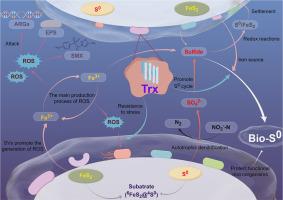当前位置:
X-MOL 学术
›
Water Res.
›
论文详情
Our official English website, www.x-mol.net, welcomes your
feedback! (Note: you will need to create a separate account there.)
Thioredoxin-Mediated Sulfur Cycling and Biogenic Sulfur Encapsulation Synergistically Enhance Co-Removal of Nitrogen, Sulfamethoxazole, and Resistance Genes in Constructed Wetlands
Water Research ( IF 11.4 ) Pub Date : 2025-05-31 , DOI: 10.1016/j.watres.2025.123939
Chenpeng Fang, Huaqing Liu, Xinhan Chen, Hui Lu, Chongyang Ren, Zhen Hu, Yifan Wang, Jian Zhang
Water Research ( IF 11.4 ) Pub Date : 2025-05-31 , DOI: 10.1016/j.watres.2025.123939
Chenpeng Fang, Huaqing Liu, Xinhan Chen, Hui Lu, Chongyang Ren, Zhen Hu, Yifan Wang, Jian Zhang

|
The interplay between sulfur-driven denitrification and antibiotic resistance genes (ARGs) proliferation remains unresolved in constructed wetlands (CWs), where sulfide accumulation and reactive oxygen species generation paradoxically enhance nitrogen removal while compromising microbial integrity. To resolve this conflict, this study engineered a FeS2@S° composite filler that synergized thioredoxin (Trx)-mediated sulfur cycling and biogenic sulfur (bio-S0) encapsulation. Upregulation of trxA/B genes (2.3-fold increase) enabled Trx to convert toxic sulfide into adhesive bio-S0, exhibiting higher microbial adhesion that shielded functional denitrifiers like Thiomonas (84.03% viability under SMX stress). Concurrently, sulfur vacancies (SVs) at FeS2 {210} crystal facets generated hydroxyl radicals (•OH) and singlet oxygen (¹O₂) via vacancy-activated pathways, selectively degrading about 73.00% of extracellular polymeric substance (EPS)-bound ARGs while suppressing horizontal gene transfer (tolC downregulation). The 6:4 FeS2@S0 system achieved 68.66% total nitrogen removal and 50.17% sulfamethoxazole degradation, outperforming conventional substrates by 28.00-39.00%, alongside a 61.24-67.31% reduction in ARG abundance. A self-sustaining sulfur cycle recycled about 89.00% of sulfides into bio-S0 or FeS2, minimizing H2S emissions (0.045 mg·m-2·h-1) and maintaining electron flux. By bridging Trx-driven redox homeostasis and bio-S0’s physical protection, this work redefines CWs as robust systems capable of simultaneous nitrogen retention, antibiotic degradation, and ARGs suppression, establishing a transformative paradigm for sustainable wastewater treatment.
中文翻译:

硫氧还蛋白介导的硫循环和生物硫包封协同增强人工湿地中氮、磺胺甲噁唑和抗性基因的共同去除
在人工湿地 (CW) 中,硫驱动的反硝化作用和抗生素抗性基因 (ARG) 增殖之间的相互作用仍未解决,其中硫化物积累和活性氧的产生自相矛盾地增强了氮去除,同时损害了微生物的完整性。为了解决这一冲突,本研究设计了一种 FeS2@S° 复合填料,该填料协同硫氧还蛋白 (Trx) 介导的硫循环和生物硫 (bio-S0) 封装。trxA/B 基因的上调(增加 2.3 倍)使 Trx 能够将有毒硫化物转化为粘合剂 bio-S0,表现出更高的微生物粘附性,从而屏蔽硫单胞菌等功能性反氮化剂(在 SMX 胁迫下存活率为 84.03%)。同时,FeS2 {210}晶面的硫空位 (SVs) 通过空位激活途径产生羟基自由基 (•OH) 和单线态氧 (¹O₂),选择性降解约 73.00% 的细胞外聚合物物质 (EPS) 结合的 ARG,同时抑制水平基因转移 (tolC 下调)。6:4 FeS2@S0 体系实现了 68.66% 的总氮去除率和 50.17% 的磺胺甲噁唑降解率,比传统基材高出 28.00-39.00%,ARG 丰度降低了 61.24-67.31%。自我维持的硫循环将约 89.00% 的硫化物回收到 bio-S0 或 FeS2 中,最大限度地减少了 H2S 的排放 (0.045 mg·m-2·h-1) 并保持电子通量。 通过弥合 Trx 驱动的氧化还原稳态和 bio-S0 的物理保护,这项工作将 CW 重新定义为能够同时保留氮、抗生素降解和 ARGs 抑制的强大系统,为可持续废水处理建立了变革性范式。
更新日期:2025-06-01
中文翻译:

硫氧还蛋白介导的硫循环和生物硫包封协同增强人工湿地中氮、磺胺甲噁唑和抗性基因的共同去除
在人工湿地 (CW) 中,硫驱动的反硝化作用和抗生素抗性基因 (ARG) 增殖之间的相互作用仍未解决,其中硫化物积累和活性氧的产生自相矛盾地增强了氮去除,同时损害了微生物的完整性。为了解决这一冲突,本研究设计了一种 FeS2@S° 复合填料,该填料协同硫氧还蛋白 (Trx) 介导的硫循环和生物硫 (bio-S0) 封装。trxA/B 基因的上调(增加 2.3 倍)使 Trx 能够将有毒硫化物转化为粘合剂 bio-S0,表现出更高的微生物粘附性,从而屏蔽硫单胞菌等功能性反氮化剂(在 SMX 胁迫下存活率为 84.03%)。同时,FeS2 {210}晶面的硫空位 (SVs) 通过空位激活途径产生羟基自由基 (•OH) 和单线态氧 (¹O₂),选择性降解约 73.00% 的细胞外聚合物物质 (EPS) 结合的 ARG,同时抑制水平基因转移 (tolC 下调)。6:4 FeS2@S0 体系实现了 68.66% 的总氮去除率和 50.17% 的磺胺甲噁唑降解率,比传统基材高出 28.00-39.00%,ARG 丰度降低了 61.24-67.31%。自我维持的硫循环将约 89.00% 的硫化物回收到 bio-S0 或 FeS2 中,最大限度地减少了 H2S 的排放 (0.045 mg·m-2·h-1) 并保持电子通量。 通过弥合 Trx 驱动的氧化还原稳态和 bio-S0 的物理保护,这项工作将 CW 重新定义为能够同时保留氮、抗生素降解和 ARGs 抑制的强大系统,为可持续废水处理建立了变革性范式。


















































 京公网安备 11010802027423号
京公网安备 11010802027423号